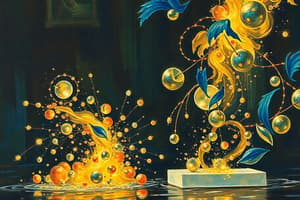Podcast
Questions and Answers
Gold reacts with hydrochloric acid (HCl).
Gold reacts with hydrochloric acid (HCl).
False (B)
Which metal reacts with strong bases to form aluminates and hydrogen gas?
Which metal reacts with strong bases to form aluminates and hydrogen gas?
- Iron (Fe)
- Silver (Ag)
- Aluminum (Al) (correct)
- Copper (Cu)
Metals with loosely held valence electrons tend to be ______ reactive.
Metals with loosely held valence electrons tend to be ______ reactive.
more
What happens when zinc metal is added to a solution of copper sulfate?
What happens when zinc metal is added to a solution of copper sulfate?
Match the metal with its reactivity to acids or bases.
Match the metal with its reactivity to acids or bases.
What is produced when metals react with oxygen?
What is produced when metals react with oxygen?
Gold reacts readily with oxygen at room temperature.
Gold reacts readily with oxygen at room temperature.
What gas is produced, along with metal hydroxides, when alkali metals react with water?
What gas is produced, along with metal hydroxides, when alkali metals react with water?
Iron reacts slowly with oxygen in the presence of moisture to form iron ________, also known as rust.
Iron reacts slowly with oxygen in the presence of moisture to form iron ________, also known as rust.
Which metal does NOT react with water or steam, even at high temperatures?
Which metal does NOT react with water or steam, even at high temperatures?
All metals react with dilute acids to produce hydrogen gas.
All metals react with dilute acids to produce hydrogen gas.
What type of product, other than metal salts, is formed when reactive metals react with dilute acids?
What type of product, other than metal salts, is formed when reactive metals react with dilute acids?
The reactivity series of metals arranges metals in order of their ________ reactivity.
The reactivity series of metals arranges metals in order of their ________ reactivity.
Flashcards
Silver's reaction with acid
Silver's reaction with acid
Silver reacts with nitric acid.
Metals reacting with bases
Metals reacting with bases
Aluminum, zinc, and tin react with strong bases to form complex ions and hydrogen gas.
Electronic configuration & reactivity
Electronic configuration & reactivity
Metals with loosely held valence electrons tend to be more reactive.
Ionization energy & reactivity
Ionization energy & reactivity
Signup and view all the flashcards
Displacement reaction
Displacement reaction
Signup and view all the flashcards
Metal Reactivity
Metal Reactivity
Signup and view all the flashcards
Reactivity Series
Reactivity Series
Signup and view all the flashcards
Reaction with Oxygen
Reaction with Oxygen
Signup and view all the flashcards
Highly Reactive Metals
Highly Reactive Metals
Signup and view all the flashcards
Reaction with Water
Reaction with Water
Signup and view all the flashcards
Alkali Metal Reactions
Alkali Metal Reactions
Signup and view all the flashcards
Reaction with Acids
Reaction with Acids
Signup and view all the flashcards
Violent Acid Reactions
Violent Acid Reactions
Signup and view all the flashcards
Study Notes
- Metals exhibit varying degrees of reactivity with oxygen, water, acids, and bases, influencing their behavior in different environments
- The reactivity series of metals arranges metals in order of their decreasing reactivity, helping predict their reactions.
Reactivity with Oxygen
- Metals react with oxygen to form metal oxides
- The rate and extent of this reaction vary greatly depending on the metal.
- Highly reactive metals like potassium (K) and sodium (Na) react vigorously with oxygen at room temperature, forming oxides rapidly.
- Magnesium (Mg) reacts with oxygen upon heating, producing bright light and heat and forming magnesium oxide (MgO).
- Iron (Fe) reacts slowly with oxygen in the presence of moisture to form iron oxide (rust) (Fe2O3).
- Gold (Au) and platinum (Pt) are unreactive with oxygen, even at high temperatures, which explains their use in jewelry and other applications where corrosion resistance is required
Reactivity with Water
- Metals react with water to form metal hydroxides and hydrogen gas
- The reactivity of metals with water varies significantly.
- Alkali metals such as lithium (Li), sodium (Na), and potassium (K) react vigorously with cold water, forming metal hydroxides and hydrogen gas.
- The reaction is exothermic, and the heat generated can ignite the hydrogen gas, leading to a fire or explosion.
- Magnesium (Mg) reacts slowly with cold water but reacts readily with steam to form magnesium oxide and hydrogen gas.
- Zinc (Zn), iron (Fe), and tin (Sn) do not react with cold water but react with steam at high temperatures to form metal oxides and hydrogen gas.
- Copper (Cu), silver (Ag), and gold (Au) do not react with water or steam, even at high temperatures
Reactivity with Acids
- Metals react with acids to form metal salts and hydrogen gas
- The reaction rate depends on the metal's position in the reactivity series and the concentration and strength of the acid.
- Reactive metals like potassium (K), sodium (Na), and calcium (Ca) react violently with dilute acids, such as hydrochloric acid (HCl) and sulfuric acid (H2SO4), producing metal salts and hydrogen gas.
- Magnesium (Mg), aluminum (Al), and zinc (Zn) react readily with dilute acids, forming metal salts and hydrogen gas.
- Iron (Fe) reacts slowly with dilute acids, forming iron salts and hydrogen gas.
- Copper (Cu) reacts with concentrated nitric acid (HNO3) and hot concentrated sulfuric acid (H2SO4) to form metal salts, water, and oxides of nitrogen or sulfur, respectively, instead of hydrogen gas.
- Silver (Ag) reacts with nitric acid (HNO3)
- Gold (Au) and platinum (Pt) do not react with most acids, including hydrochloric acid (HCl) and sulfuric acid (H2SO4).
Reactivity with Bases
- Some metals react with strong bases to form complex ions and hydrogen gas
- The reaction is more complex than with acids and is limited to a few metals.
- Aluminum (Al) reacts with strong bases like sodium hydroxide (NaOH) and potassium hydroxide (KOH) to form complex ions called aluminates and hydrogen gas.
- Zinc (Zn) reacts with strong bases like sodium hydroxide (NaOH) and potassium hydroxide (KOH) to form complex ions called zincates and hydrogen gas.
- Tin (Sn) reacts with strong bases like sodium hydroxide (NaOH) and potassium hydroxide (KOH) to form complex ions called stannates and hydrogen gas.
- Other metals, such as iron (Fe), copper (Cu), and silver (Ag), do not react with bases.
Factors Affecting Reactivity
- Electronic Configuration: Metals with loosely held valence electrons tend to be more reactive as they readily lose electrons to form positive ions
- Ionization Energy: Metals with low ionization energies are more reactive because they require less energy to lose electrons
- Atomic Size: Larger atomic size generally corresponds to higher reactivity since the valence electrons are further from the nucleus and easier to remove
- Metallic Bonding: Metals with weaker metallic bonds are generally more reactive as less energy is required to break the bonds during a reaction
- Surface Conditions: The presence of oxide layers or impurities on the metal surface can affect its reactivity:
Displacement Reactions
- A more reactive metal can displace a less reactive metal from its salt solution
- This principle is used in various industrial processes, such as the extraction of metals from their ores.
- For example, zinc (Zn) is more reactive than copper (Cu), so when zinc metal is added to a solution of copper sulfate (CuSO4), zinc displaces copper from the solution, forming zinc sulfate (ZnSO4) and depositing copper metal.
Studying That Suits You
Use AI to generate personalized quizzes and flashcards to suit your learning preferences.




